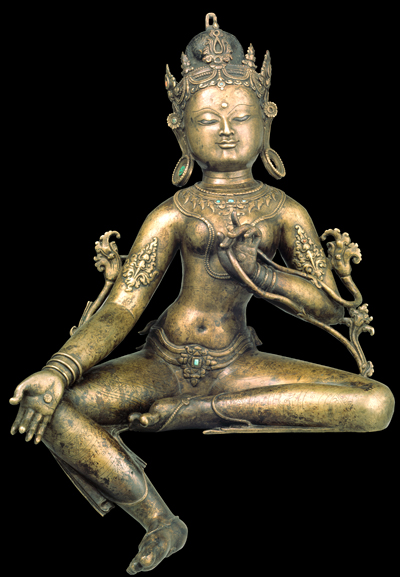
This fall, as the UN Convention on Climate Change approaches, we’re examining the collective efforts needed to impact global climate change in our conversation series, Karma: Cause, Effect, and the Illusion of Fate. Many of our art objects also represent the ideas of cause and effect, and Green Tara is one deity that certainly knows how to take action.
If you’re looking for motivation, here are eight ways to learn from Tara, a sculpture of whom is on view in the exhibition Gateway to Himalayan Art.
1) Tara is one of the most beloved deities in the Himalayan and Inner Asian Buddhist traditions. In images and statues showing her with a lotus in her left hand, she is Shyama Tara, or Green Tara. Outside of Buddhist cultures, “green” connotes an association with the environment and conservation efforts.
2) Tara is wisdom personified in female form. In addressing the difficult ecological questions facing us today, we can all understand the need for more Tara-like wisdom.
3) In the sculpture below, Tara is in the “pose of royal ease.” Her right leg is extended so she is ready to rise instantly to action if needed. Similarly we need to be prepared to stand up for the health and future of our planet.

4) Tara’s appearance as a richly adorned, beautiful queen of ancient India represents the eternal desire for truly wise and compassionate world leaders. Tara for president!
5) Tara’s name can translate as “Savioress” and her title is “The Mother of All Activities.” This powerhouse lady can multitask! People working to solve complex issues can certainly benefit from that aptitude.
6) The other translation for Tara is “Star” and she is associated with the North Star—one of the clearest heavenly bodies used universally for safe navigation. Tara can symbolically guide environmental efforts as leaders explore new solutions to ecological problems.
7) Tara protects people from the Eight Fears, which can be physical world problems or inner psychological difficulties and include: sickness, drowning, fire, false imprisonment, bandits, wild elephants, snakes, and lions.
8) Green Tara represents the potential for life, and with life, the capacity for people to change and even transcend.
If the environment is important to you, you’ll enjoy Karma: Cause, Effect, and the Illusion of Fate, the Rubin’s fall conversation series that examines the repercussions of our actions, with a focus on mankind’s effect on the climate.
View upcoming talks, events, and film screenings in the Karma series.

